Haps
-
- Adances in Marine Coatings & Corrosion Control Maritime Reporter, Mar 2013 #46
Keeping hulls and equipment ship shape, coatings play critical role in vessel efficiency, economy
The advance of modern marine coatings and related technologies is not unlike other technical sectors of the maritime industry, primarily driven by emerging regulation from the international, national and regional level, usually in regard to environmental concern.
But in recent years, an increased focus on the reduction of marine emissions in tandem with the capability to more directly correlate clean, well-maintained hulls with reduced fuel consumption and lower emissions has driven the industry further faster, as coatings manufacturers globally strive for new formulations designed to apply easier, wear longer and ultimately become an indispensible tool in the vessel owner’s arsenal to run cleaner, more efficient vessels.
The Coatings
Late last year Hempel launched Hemparea 55973, a fast-drying anticorrosive coating suitable for C3 corrosive environments with a cure time of just one hour. Its quick dry time, along with a single-coat combination of primer and topcoat, increases line-speeds for heavy machinery by at least 50% in comparison to standard two and three coat systems, the manufacturer claims, helping to complete the coating process in a timelier, more cost-efficient manner.
New to the market are International Paint’s two latest antifouling coatings, Intercept 8000 LPP and Intersleek 1100SR. Intercept 8000 LPP, is a biocidal linear polishing polymer antifouling featuring patented Lubyon technology that is designed to deliver predictable long term performance for in-service periods up to 90 months, International reports, and Intersleek 1100SR, is a biocide free fouling control coating featuring slime release technology that combats micro fouling on ships hulls, maintaining performance throughout the docking cycle
Lubyon polymer technology (found in Intercept 8000) aims to give the coating a ‘superhydrophilic’ surface. International explains, when the coating is immersed, the seawater has a lubricating effect, resulting in less friction, thus reducing drag and increasing vessel efficiency to give average fuel consumption and associated emissions savings of 5% annually compared to typical controlled depletion polymer antifoulings.
Intersleek 1100SR, reported to be the shipping industry’s first biocide free, fluoropolymer technology that tackles the ‘slime challenge.’ According to a recent formula produced by Michael P. Schultz, Professor, Department of Naval Architecture & Ocean Engineering, US Naval Academy, at today’s bunker prices, the effects of slime potentially costs the shipping industry 44 million extra tons of bunker fuel, $28.6 billion in additional fuel costs and an extra 134 million tons of CO2 emissions every year. Designed for all commercial vessels, even when slow or ultra slow steaming, Intersleek1100SR slime release technology is designed to deliver macro and micro fouling control with static resistance even in warm waters.
Sigma Ecofleet 690 is designed to provide high performance antifouling for short sea and coastal shipping, the newest addition to the Sigma Ecofleet range which provides predictable antifouling protection at variable operating speeds in aggressive fouling environments. Developed specifically for the dry dock, maintenance and repair market, Sigma Ecofleet 690 has been formulated using PPG’s unique patented binder technology ensuring consistent performance levels and fouling control for in-service periods of up to 60 months.
Fully compliant with the IMO AFS Convention, the product is suitable for a wide range of vessel types and contains an ultra-high volume solids content of 70% - thus reducing potential VOC emissions. Sigma Ecofleet 690 has been formulated to be easy to apply, increasing productivity and reducing overall maintenance costs.
Funded by the U.S. Office of Naval Research and the Materials Research Science and Engineering Center, Duke University engineers have produced a hull coating that dislodges bacteria with the application of an electrical current, thus avoiding the use of bacteria-killing paints which can contain heavy metals or other toxic chemicals that might harm fish or other sea life. The material works by physically moving at the microscopic level, knocking away bacteria. “We have developed a material that ‘wrinkles,’ or changes its surface in response to a stimulus, such as stretching or pressure or electricity,” said Duke engineer Xuanhe Zhao, assistant professor in Duke’s Pratt School of Engineering. “This deformation can effectively detach biofilms and other organisms that have accumulated on the surface.”
Micanti, a Holland-based maritime technology company, introduced an environmentally friendly antifouling option called Thorn-D. A nontoxic adhesive foil used in place of environmentally contaminating chemical coatings, Thorn-D has a textured surface that prevents marine growth from attaching to the hull. “The basic thought behind Thorn-D is that a combination of prickliness and swaying of Thorn-D fibers makes the surface unattractive for organisms,” said Micanti founder, Dr. Rick Breur, in a recent press release. “The technology provides a physical barrier in the shape of specific short fibers for organisms such as mussels, barnacles and algae to settle.”
Also declaring reduced application costs, Sherwin-Williams launched Macropoxy 80, a high-build HAPs-free epoxy formulated for application over marginally prepared steel substrates and damp surfaces, lessening the need for costly surface preparations. The coating combats corrosion from both immersion and atmospheric exposures and can be applied at temperatures as low as 0°F. Because of its surface tolerance, Macropoxy 80 can be applied in adverse conditions, and steel substrates need only to be cleaned of loose paint or rust per SSPC SP2-3 Hand and Power Tool Cleaning before application. Its high solids formulation (80%) reduces the likelihood of the solvent entrapment that can lead to premature coating failure. In addition to being HAPS-free, Macropoxy 80 is low-VOC (<250 g/L).
GuardLine LTC (Low Temperature Cure), a new cargo tank coating from Advanced Polymer Coatings, is an ambient-cure coating (in the range of 77°F) used on chemical, product and barge tankers to transport a range of liquid cargos. GuardLine LTC only requires a low temperature cure, generating cost savings by eliminating the extra step of a high temperature forced hot air heat cure, which is crucial for the high chemical resistance of the MarineLine 784 system used for chemical tankers and their more hazardous cargos.
APC also claims its LTC coating offers greater versatility and chemical resistance and requires less cleaning because it is virtually absorbent-free, giving ship operators the opportunity to carry a wider range of cargos without worrying about the previous cargo residue contaminating the next one.Advanced Polymer Coatings
www.ad-polymer.com
Hempel
www.hempel.com
International Paints
www.international-marine.com
Micanti
www.micanti.com
PPG Protective & Marine Coatings
www.ppg.com
Sherwin-Williams
www.sherwin-williams.comMarch 17-21, 2013
Orange County Convention Center, Orlando, FL
The 2013 NACE International Corrosion Conference offers technical and educational resources, public awareness activities and exhibition. More than 5,000 corrosion professionals are expected to participate, and the exhibition will feature more than 370 companies displaying the latest in corrosion control products and services. The technical program, with more than 30 symposia, will feature several new offerings, including corrosion mitigation of fire protection systems, corrosion issues related to water systems and the environment and the relationship between coatings and CP.
www.nace.org
(As published in the March 2013 edition of Maritime Reporter & Engineering News - www.marinelink.com)
-
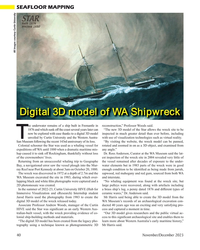 )
November 2023 - Marine Technology Reporter page: 40
)
November 2023 - Marine Technology Reporter page: 40SEAFLOOR MAPPING All images courtesy Curtin University Digital 3D model of WA Shipwreck he underwater remains of a ship built in Fremantle in reconstruction,” Professor Woods said. 1876 and which sunk off the coast several years later can “The new 3D model of the Star allows the wreck site to be now be
-
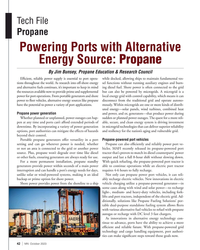 )
October 2023 - Marine News page: 42
)
October 2023 - Marine News page: 42Tech File Propane Powering Ports with Alternative Energy Source: Propane By Jim Bunsey, Propane Education & Research Council Ef? cient, reliable power supply is essential to port opera- while docked, allowing ships to maintain fundamental ves- tions throughout the world. As research into off-shore
-
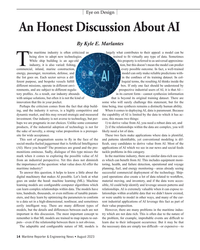 )
August 2023 - Maritime Reporter and Engineering News page: 14
)
August 2023 - Maritime Reporter and Engineering News page: 14is beyond its original training dataset. There are innovation that ? ts in your pocket. some who will surely challenge this statement, but for the Perhaps the criticism comes from the fact that ship build- time being, true synthesis remains a distinctly human ability. ing, and the industry it serves,
-
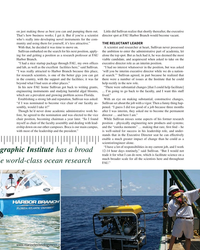 )
May 2023 - Marine Technology Reporter page: 37
)
May 2023 - Marine Technology Reporter page: 37on just making those as best you can and pumping them out. Little did Sullivan realize that shortly thereafter, the executive That’s how business works; I get it. But if you’re a scientist director spot at FAU Harbor Branch would become vacant. who’s really into developing novel instruments for the
-
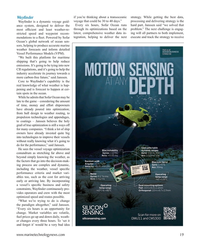 )
March 2023 - Marine Technology Reporter page: 19
)
March 2023 - Marine Technology Reporter page: 19if you’re thinking about a transoceanic strategy. While getting the best data, Way? nder voyage that could be 30 to 40 days.” processing and delivering strategy is the Way? nder is a dynamic voyage guid- Every six hours, Sofar Ocean runs hard part, Janssen said “we solved that ance system, designed
-
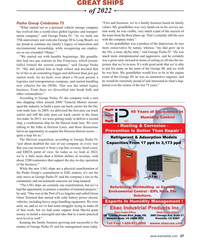 )
December 2022 - Maritime Reporter and Engineering News page: 27
)
December 2022 - Maritime Reporter and Engineering News page: 27GREAT SHIPS of 2022 “First and foremost, we’re a family business based on family Pasha Group Celebrates 75 “What started out as a personal vehicle storage company values. My grandfather was very hands-on in his service sta- tion work; he was visible, very much a part of the success of has evolved into a
-
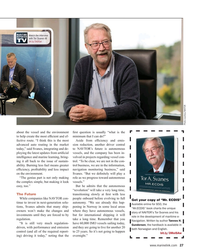 )
June 2022 - Maritime Reporter and Engineering News page: 27
)
June 2022 - Maritime Reporter and Engineering News page: 27Watch the interview with Tor Svanes @ bit.ly/3xbXaii Photo courtesy NAVTOR about the vessel and the environment ? rst question is usually “what is the to help create the most ef? cient and ef- minimum that I can do?” fective route. “I think this is the most Aside from ef? ciency and emis- advanced
-
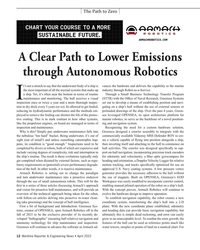 )
April 2022 - Maritime Reporter and Engineering News page: 12
)
April 2022 - Maritime Reporter and Engineering News page: 12The Path to Zero A Clear Path to Lower Emissions through Autonomous Robotics t’s not a stretch to say that the underwater body of a ship is vances the hardware and delivers the capability to the marine the most important of all the myriad systems that make up industry through Robot-as-a-Service. a ship.
-
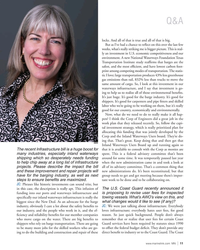 )
March 2022 - Marine News page: 11
)
March 2022 - Marine News page: 11Q&A locks. And all of that is true and all of that is big. But as I’ve had a chance to re? ect on this over the last few weeks, what’s really striking me is bigger picture. This is real- ly an investment in U.S. economic competitiveness and our environment. A new National Waterways Foundation Texas
-
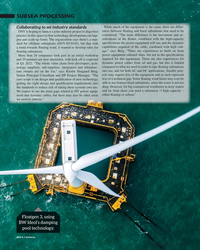 )
January 2022 - Marine Technology Reporter page: 16
)
January 2022 - Marine Technology Reporter page: 16SUBSEA PROCESSING While much of the equipment is the same, there are differ- Collaborating to set industry standards ences between ? oating and ? xed substations that need to be DNV is hoping to launch a joint industry project to align best considered. “The main difference is the movement and ac- practice
-
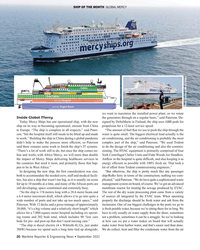 )
September 2021 - Maritime Reporter and Engineering News page: 20
)
September 2021 - Maritime Reporter and Engineering News page: 20SHIP OF THE MONTH GLOBAL MERCY Photo courtesy Mercy Ships we want to maximize the installed power plant, so we rotate Inside Global Mercy the generators through on a regular basis,” said Paterson. De- Today Mercy Ships has one operational ship, with the new signed by DeltaMarin in Finland, the ship uses
-
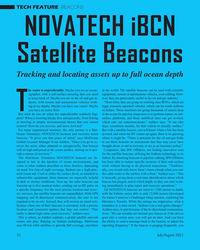 )
July 2021 - Marine Technology Reporter page: 52
)
July 2021 - Marine Technology Reporter page: 52TECH FEATURE BEACONS NOVATECH iBCN Satellite Beacons Tracking and locating assets up to full ocean depth he water is unpredictable. Maybe you are an ocean- in the world. The satellite beacons can be used with scienti? c ographer, with a sub-surface mooring that you need equipment, remote or autonomous
-
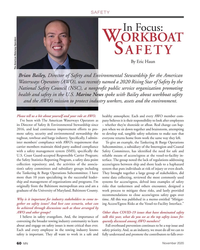 )
November 2020 - Marine News page: 60
)
November 2020 - Marine News page: 60SAFETY In Focus: W S ORKBOAT AFETY By Eric Haun The American Waterway Operators Brian Bailey, Director of Safety and Environmental Stewardship for the American Waterways Operators (AWO), was recently named a 2020 Rising Star of Safety by the National Safety Council (NSC), a nonpro? t public service
-
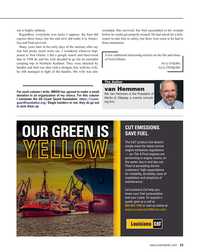 )
November 2020 - Maritime Reporter and Engineering News page: 15
)
November 2020 - Maritime Reporter and Engineering News page: 15out is highly unlikely. wounded. She survived, but Ned succumbed to his wounds Regardless, everybody was lucky I suppose, the boat did before he could get properly treated. He had asked for a heli- capsize three times, but she and crew did make it to Antarc- copter to take him to safety, but there were
-
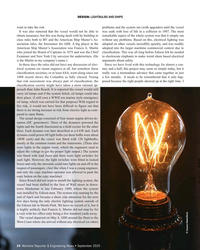 )
September 2020 - Maritime Reporter and Engineering News page: 24
)
September 2020 - Maritime Reporter and Engineering News page: 24DESIGN: LIGHTBULBS AND SHIPS want to take the risk. problems and the system ran (with upgrades) until the vessel It was also rumored that the vessel would not be able to was sunk with loss of life in a collision in 1907. The most obtain insurance, but this was being dealt with by building to remarkable
-
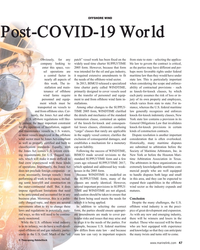 )
June 2020 - Maritime Reporter and Engineering News page: 47
)
June 2020 - Maritime Reporter and Engineering News page: 47space, ves- 2005 form. However, because that form as the parties may have different and per- sel operations are was intended for the oil and gas industry, haps more favorable rights under federal a central factor in it required extensive amendments to fit maritime law than they would have under nearly all
-
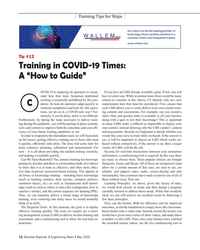 )
May 2020 - Maritime Reporter and Engineering News page: 12
)
May 2020 - Maritime Reporter and Engineering News page: 12Training Tips for Ships Tip #12 Training in COVID-19 Times: A “How to Guide” OVID-19 is requiring all operators to recon- If you have an LMS already available, great. If not, you will sider how they train. In-person traditional have to select one. While in normal times there would be many training is
-
 )
April 2020 - Maritime Reporter and Engineering News page: 58
)
April 2020 - Maritime Reporter and Engineering News page: 58world. That will be the deal breaker. tions would require compliance, but per- compliance and effcient sailing. We can do this if we work together. And, haps the fnancial burden could be shifted These are relatively modest measures if the corona pandemic has proven any- to government – in the same way as
-
 )
February 2020 - Maritime Reporter and Engineering News page: 18
)
February 2020 - Maritime Reporter and Engineering News page: 18Back to the Drawing Board © tonjung/AdobeStock Marine Casualties Don’t Miss the Near Misses We all know that maritime can be perfectly safe, as long as we all know it is very dangerous. Knowing something is dangerous may not be as easy to ? gure as we like to think. y company has been involved in Maritime
-
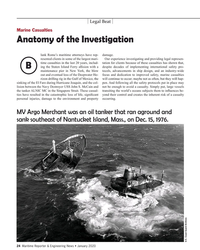 )
January 2020 - Maritime Reporter and Engineering News page: 24
)
January 2020 - Maritime Reporter and Engineering News page: 24Legal Beat Marine Casualties Anatomy of the Investigation lank Rome’s maritime attorneys have rep- damage. resented clients in some of the largest mari- Our experience investigating and providing legal represen- time casualties in the last 20 years, includ- tation for clients because of these casualties
-
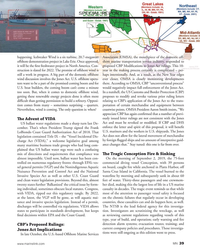 )
December 2019 - Marine News page: 39
)
December 2019 - Marine News page: 39. The promise of offshore wind is year in the making process certainly is complicated – per- still a work in progress. A big part of the domestic offshore haps intentionally. And, as a result, as the New Year edges wind discussion involves the Jones Act. U.S. offshore opera- ever closer, OMSA is closely monitoring
-
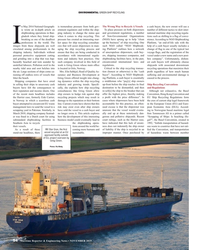 )
November 2019 - Maritime Reporter and Engineering News page: 54
)
November 2019 - Maritime Reporter and Engineering News page: 54ENVIRONMENTAL GREEN SHIP RECYCLING n May 2014 National Geograph- is tremendous pressure from both gov- The Wrong Way to Recycle A Vessels a cash buyer, the new owner will use a ic wrote an in-depth article on ernment regulators and within the ship- To place pressure on both shipowners number of different
-
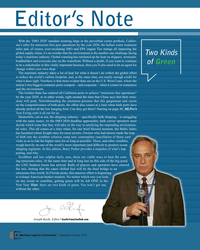 )
Sep/Oct 2019 - Maritime Logistics Professional page: 8
)
Sep/Oct 2019 - Maritime Logistics Professional page: 8Editor’s Note With the ‘IMO 2020’ mandate looming large in the proverbial center porthole, Califor- nia’s edict for emissions-free port operations by the year 2030, the ballast water treatment rules and, of course, ever-escalating IMO and EPA engine Tier ratings all impacting the global supply chain
-
 )
March 2019 - Marine News page: 46
)
March 2019 - Marine News page: 46with industry, to 0.7 percent.” a look at the data that leads us to the conclusion that per- It is that very kind of logic that the Coast Guard can haps we need to initiate a rule-making to encompass all of bring to the table when it is time to make the argument the marine industry in the United States
